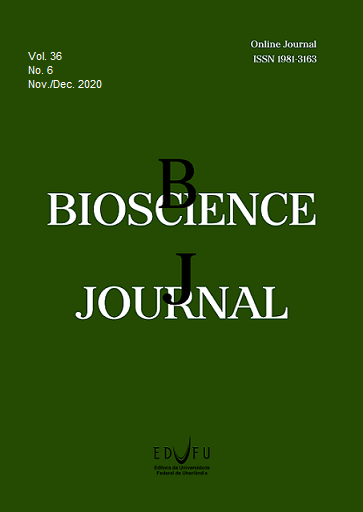Production, physicochemical quality and antioxidant capacity of ‘Niagara Rosada’ grape grafted on different rootstocks
DOI:
https://doi.org/10.14393/BJ-v36n6a2020-48198Keywords:
Vitis labrusca., Table grape., Phenolic compounds., Antioxidant activity.Abstract
The objective of this study is to evaluate the effect of rootstocks on grape production, quality and antioxidant capacity of ‘Niagara Rosada’ grape in two productive cycles. The work was developed in Jundiaí-SP, Brazil (26° 06’ S, 46° 55’ W and an average altitude of 745 m). The experimental design was in randomized blocks with subdivided plots, the plots being represented by the rootstocks and the subplots by the production cycles, with four replications, each consisting of 6 plants. The treatments consisted of a combination of ‘IAC 313 Tropical’, ‘IAC 572 Jales’, ‘IAC 571-6 Jundiaí’, ‘IAC 766 Campinas’ and ‘106-8 Mgt’ as rootstocks and ‘Niagara Rosada’ as graft, and the production cycles were 2013 and 2014. The number of bunches, production and productivity of the vines, the physical characteristics of bunches, berries and stalks and the physicochemical composition of the must (soluble solids content, titratable acidity, pH and the relation soluble solids/titratable acidity) were evaluated in production cycles of 2013 and 2014). The content of chlorophylls, anthocyanins, carotenoids, flavonoids and total phenolic compounds and the antioxidant activity of grapes were also evaluated in grape berries. The rootstocks did not influence the production and physical quality of ‘Niagara Rosada’ grapes. As for the chemical characteristics, rootstocks only had an effect on solids content, and ‘IAC 766’ and ‘106-8 Mgt’ rootstocks promoted higher values of this characteristic. Likewise, the total phenolic compounds and the antioxidant activity of the grapes were not influenced by the studied rootstocks. The vines in 2013 presented higher production and better physical characteristics of the grapes, however, the soluble solids content in this cycle was lower than in 2014.
Downloads
Published
Issue
Section
License
Copyright (c) 2020 Bruna Thaís Ferracioli Vedoato, Francisco José Domingues Neto, Adilson Pimentel Junior, Ana Paula Maia Paiva, Marlon Jocimar Rodrigues da Silva, Mara Fernandes Moura, Giuseppina Pace Pereira Lima, Marco Antonio Tecchio

This work is licensed under a Creative Commons Attribution 4.0 International License.





